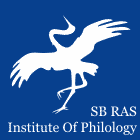 |
|
||||||||||||
|
Institute of Philology of
the Siberian Branch of Russian Academy of Sciences |
|
||||||||||||
|
|||||||||||||
DOI: 10.25205/2410-7883 Roskomnadzor certificate number Эл № ФС 77-84792 | |
| Syuzhetologiya i Syuzhetografiya | |
|
Article
Authors: Tatiana I. Kovaleva Institute of Philology of the Siberian Branch of the Russian Academy of Sciences, Novosibirsk, Russian Federation In the section Literary Life of the Plot
Abstract: The article deals with the manuscript copies of the Legend of the Abalak icon of the Theotokos. The analysis shows the absence of the miracle dedicated to its main heroine, widow Maria, at the early stage of the work’s existence (the first quarter of the 17th century). It is conventionally called in the article the miracle of the earrings. This story can be found only in later copies of the 18th century. Opening the list of miracles from the icon, it seems illogical, since it is not directly connected with the main events of the Legend (the founding of the church and the creation of the Abalak Icon of the Theotokos). This miracle and its role are examined by comparing the only early copy and the invariant copy of the 18th century. The miracle of the earrings in the later copy echoes in meaning the previous apparitions of the icon of the Theotokos. In general, the apparitions and the miracle are a complete plot connected to the main heroine. It is connected with the idea of the transition of the Siberian land from paganism to the Christian faith. This idea is only outlined in the early copy of the Legend, and the heroine’s function is limited to her story about the apparitions. Concluding the heroine’s story, it refers the reader to a broad biblical context related to earrings, silver, other jewelry and metals. Moreover, like a gospel parable, it explains the idea of striving for spiritual values. Keywords: Russian literature of Siberia, Tobolsk Archpriests’ House, legends on icons, the Abalak Icon of the Theotokos, manuscript tradition, plot formation Bibliography: Kovaleva T. I. Rannii tomskii spisok “Skazaniya o yavlenii i chudesakh Abalatskoi ikony Bogoroditsy v Tobol’ske” v istorii syuzheta sochineniya [Early tomsk copy of “The legend on the apparition and miracles of the Abalak icon of the most holy Theotokos in Tobolsk” in the history of the plot of the work]. Drevnyaya Rus’. Voprosy mediyevistiki [Old Russia. The questions of middle ages], 2022, no. 3, pp. 193–203. (in Russ.) Kovaleva T. I. “Skazanie o yavlenii i chudesakh Abalatskoi ikony Bogoroditsy”: Rannii tomskii spisok (tekst i kommentarii) [“The legend on the apparition and miracles of the Abalak icon of the most holy Theotokos in Tobolsk”: Early tomsk copy (text and comments)]. In: Pamyat’ o proshlom v pis’mennykh istochnikakh XVII–ХХ vv. [Memory of the past in written sources of the 17th – 20th centuries]. Novosibirsk, 2023, pp. 291–309. (in Russ.) (Archeography and source studies of Siberia; issue 42) Literaturnye pamyatniki Tobol’skogo arkhiereiskogo doma XVII v. [Literary Monuments of the Tobolsk Archpriests’ House of the 17th Century]. Ed. and prepared by E. K. Romodanovskaya, O. D. Zhuravel. Novosibirsk, 2001, 439 p. (in Russ.) Romodanovskaya E. K. Sibirskie povesti ob ikonakh (XVII – nachalo XVIII v.) [Siberian Stories on Icons (the 17th – the Beginning of the 18th Century)]. In: Osvoenie Sibiri v epokhu feodalizma [The development of Siberia in the era of feudalism]. Novosibirsk, 1968, pp. 82–96. (in Russ.) Romodanovskaya E. K. Sibir’ i literatura: XVII vek [Siberia and Literature: The 17th Century]. Novosibirsk, 2002? 391 p. (in Russ.) Slavyano-russkie rukopisi Nauchnoi biblioteki Tomskogo gosudarstvennogo universiteta: Katalog [Slavonic and Russian manuscripts of the Scientific library of the Tomsk state university: The catalogue]. Comp. by V. A. Esipova. Tomsk, 2007, iss. 1: The 15th – 17th Centuries, 424 p. (in Russ.) Slovar’ bibleyskikh obrazov [Dictionary of Biblical Images]. General editorship of L. Raiken, J. Wilhoit, T. Longman III; trans. by B. A. Skorokhodov, O. A. Rybakova. St. Petersburg, 2005, 1423 p. (in Russ.) Yurevsky A. Redkii pamyatnik sibirskoi dukhovnoi pis’mennosti pervoi poloviny XVII veka [A rare monument of Siberian spiritual writing of the first half of the 17th century]. Tobol’skie eparkhial’nye vedomosti [Tobolsk diocesan news], 1902, no. 24, chapter unofficial, pp. 447–464. (in Russ.) |
 |
Institute of Philology Nikolaeva st., 8, Novosibirsk, 630090, Russian Federation +7-383-330-15-18, ifl@philology.nsc.ru |
© Institute of Philology |


